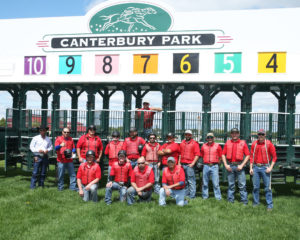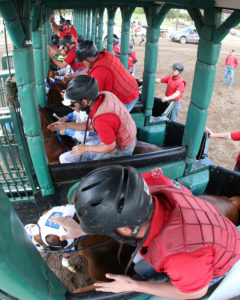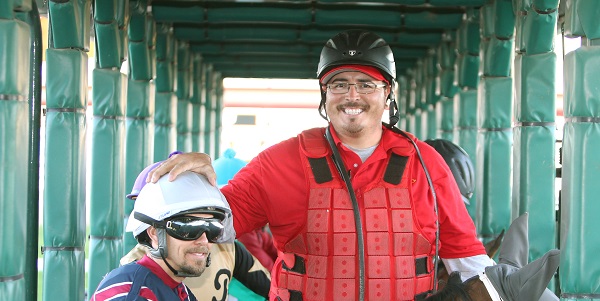BY JIM WELLS
Remember Seabiscuit? If you’re a racing fan, you’ve surely read about the diminutive champion and the positive influence he had on Americans from coast to coast during the Great Depression.
Or maybe you saw the movie!
As Oscar Quiroz did…several times. He bought the DVD when it came out, for personal reasons and interest in the film itself. After all, it was about racing and a famous racehorse.
Quiroz is a valet and also works on the gate Canterbury Park each summer, after spending the winter in his home state of Arizona working the gate at Turf Paradise.

He became attracted to racing as a boy, largely because of a grandfather who resided not far from where he spent his youth, in Tucson.
He was a youngster, maybe 17, and working at Rillito Park in Tucson when movie engineers for an upcoming film showed up to record the sounds of horses racing on the turn, and the sound of the starting bell. Only later on, after the work was completed and he had watched the film, did he come to understand completely the role he had played and its place in the film.
The engineers arrived at Rillito that day to record sound for an upcoming movie about Seabiscuit, a son of Hard Tack and grandson of the immortal Man of War. (The movie was released in late July, 2003).
Hardtack was a kind of biscuit or cracker that sailors consumed at sea, a meal accompaniment that survived well during voyages. It was an easy transition from there to the name given the 1938 American Horse of the Year.
Seabiscuit was so honored after taking on 1937 Triple Crown winner War Admiral in a much ballyhooed match race at Pimlico Racecourse, a race he won by a solid four lengths and commanded throughout.
He was a mere 15 hands at maturity yet grew into an inspiration to a nation during a period of financial stress that plagued the citizenry across the land.
If a smallish, indeed undersized, thoroughbred could overcome the odds as Seabiscuit did, why couldn’t struggling men and women draw hope from such an example and apply it to their own lives.
Seabiscuit was to horse racing and the nation what James J. Braddock had been to boxing and the country in 1935, when he, too, overcame seemingly insurmountable odds to win the world heavyweight title. And today Quiroz can relish his small part in the making of a film about a legendary horse, the fifteen minutes of fame that the artist Andy Warhol predicted would enter all of our lives at one time or another.
Racing is part of Oscar’s family genes, so to speak, and can be found throughout his genetic code, his love for everything about the sport, and somewhere deep within, he has a desire to work the gate, to be part of the start of every race, a job he relishes despite several painful incidents with fractious horses over the years that have left him limping on occasion.
His grandfather, Rudy Rodriguez, raced a couple of horses throughout the fair circuit when Quiroz was a youngster and he became taken with the idea of horses and the racetrack at an early age.
“My grandfather was from Patagonia (Arizona) and he had a ranch in Nogales. He got me interested,” Oscar recalled. “I used to help him clean stalls.
Later Quiroz, again due to his grandfather, got to hang out with the guys at the starting gate at Prescott Downs, and a starter named Lee Peterson, who worked at Rillito as well.
“Let me know if you ever need help in Tucson,” Quiroz told him. He didn’t have to wait long. “I got a call the next winter,” he said. And thus began a career that has taken him several places over the years and every summer to Shakopee.
For Quiroz, the opportunity to work the gate was golden, a chance to do a job he had admired since boyhood, and he settled into the new occupation with ease.
Then, some time later, came that memorable day at Rillito, when he was told by a track official that a film crew would be there the following day. Quiroz, it turned out, was asked to ring the starter’s bell whenever needed for the film recorders. He is reminded of that role whenever he watches the movie and hears the distinctive sound.
“Hey, that’s the bell at Rillito,” he eagerly told a friend after watching the film for the first time.
He recalled the sound engineers taking advantage of short opportunities to do their work. “They were there for most of the day, and would record between races while the horses were being saddled, ” he said.
Different parts of the movie were filmed at various tracks around the country, including Santa Anita Park in California. Several gate crew members seen during the match race in the film are men Quiroz worked with at Los Alamitos and Hollywood Park. “I knew all of those guys,” he said.
Seabiscuit, as Braddock before him, had several missteps in his career before finding the footing that would make him a hero to a nation in need during the great financial crisis.
He didn’t break his maiden until his 18th attempt, thereafter finding the wherewithal that carried him to a career record of 33-15-13 in 89 starts and earnings of $437,730, not bad during a time when money was hard to come by for the majority of Americans.
Quiroz was asked recently how long it had been since he watched the movie. “I don’t know,” he said. “I’m not sure where the DVD is right now.”
Just the same, he plans to dig it up and rewatch, for the umpteenth time, the story about the great little champion that includes his small contribution, his 15 minutes of fame.
